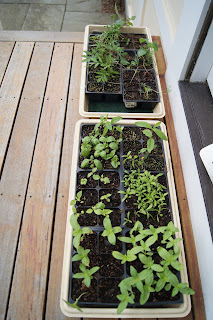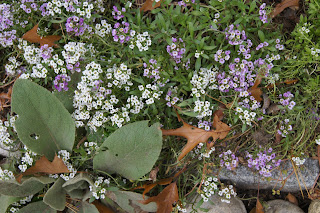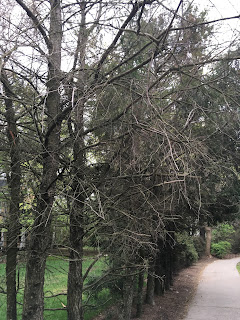 |
| Squirrel at work--photo by pelican |
A fair percentage of the seeds I planted indoors this spring succeeded in growing into little plants around four inches tall. I hardened them off, moving them outdoors for lengthening periods over a couple of weeks to make sure they were ready for this season’s wildly oscillating temperatures.
 |
| Toughening up to live outdoors |
Then there were delays during days of heavy rain that kept me out of the garden for fear of trampling the soil into concrete.
In the last three weeks I used whatever dry days there were for planting the seedlings out. Most were headed for the fenced, rabbit-proof vegetable plot.
 |
| The vegetable garden fence reaches 12 inches underground to keep rabbits out |
Basil and dill seedlings landed in a corner dedicated to herbs. Nearby I also planted seeds of peas, cucumbers, and beans directly in the ground.
Opposite the herbs is a section that stays dry and partially shaded because of a neighbor’s tall red oak. The tree’s branches extend above the vegetable plot, and its roots efficiently draw up whatever irrigation I provide. This area can’t sustain vegetables, so it has become an insectary garden offering food and shelter for native insects.
This month I added some seedlings of common milkweed (Asclepias syriaca) and cockscomb (Celosia species) to it and edged the path that bisects the vegetable bed with sweet alyssum (Lobularia maritima).
 |
| Sweet alyssum attracts pollinators and has a honey scent |
Near the insectary bed, I’m hoping to produce flowers for cutting. In that section I planted the zinnias, bachelor’s buttons, and cosmos I started indoors with hopes of enjoying summer bouquets. Some spider flower (Cleome hassleriana) that had popped up in the homemade potting mix came along too. The flowers of these easy annuals are popular with pollinators.
 |
| Exuberant zinnias at Locust Grove in Poughkeepsie, NY |
So far the sustainable-enough approach was working. I’d managed to procure most of the annuals I wanted without resorting to seeds or plants treated with neonicotinoid insecticides. I’d gotten the young plants safely into the garden. That’s when squirrels became a menace.
When I dig, squirrels follow after me, digging in the same spot and throwing the young seedlings I’ve planted out of the ground. If I don’t notice and replant them, the exposed roots dry up and the little plants die. Squirrels don’t seem to want to eat the seedlings (except sunflowers, which must have delicious sprouts). Maybe they suspect I’ve buried nuts. Whatever the reason for this behavior, it’s very frustrating.
To foil this sabotage, wherever I dug in the vegetable garden, I had to cover the loosened soil with wire fencing and then anchor row cover fabric on top of it.
 |
| Row cover fabric lets water and light through and keeps squirrels out |
That gave the vegetable seeds and the young seedlings a chance to take root. Yesterday, after the row cover had been in place for two weeks, I lifted it off. I left the fencing in place.
 |
| Lettuce and greens growing through the wire fencing |
I covered the bare soil with leaf mulch. Here’s hoping I’ve outsmarted the squirrels, and they’ll dig somewhere else.
 |
| Are these pea plants old enough to be squirrel-proof? |



























